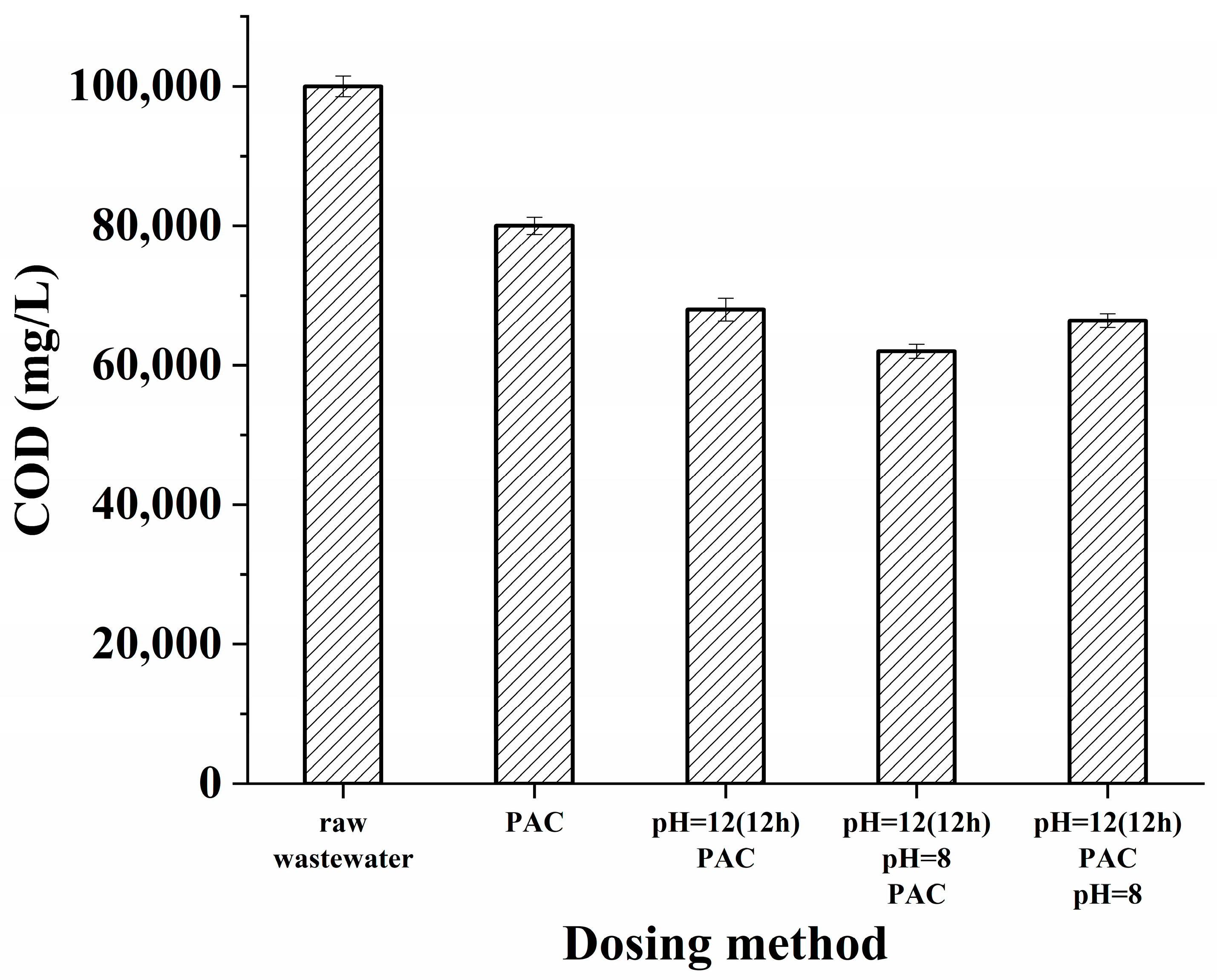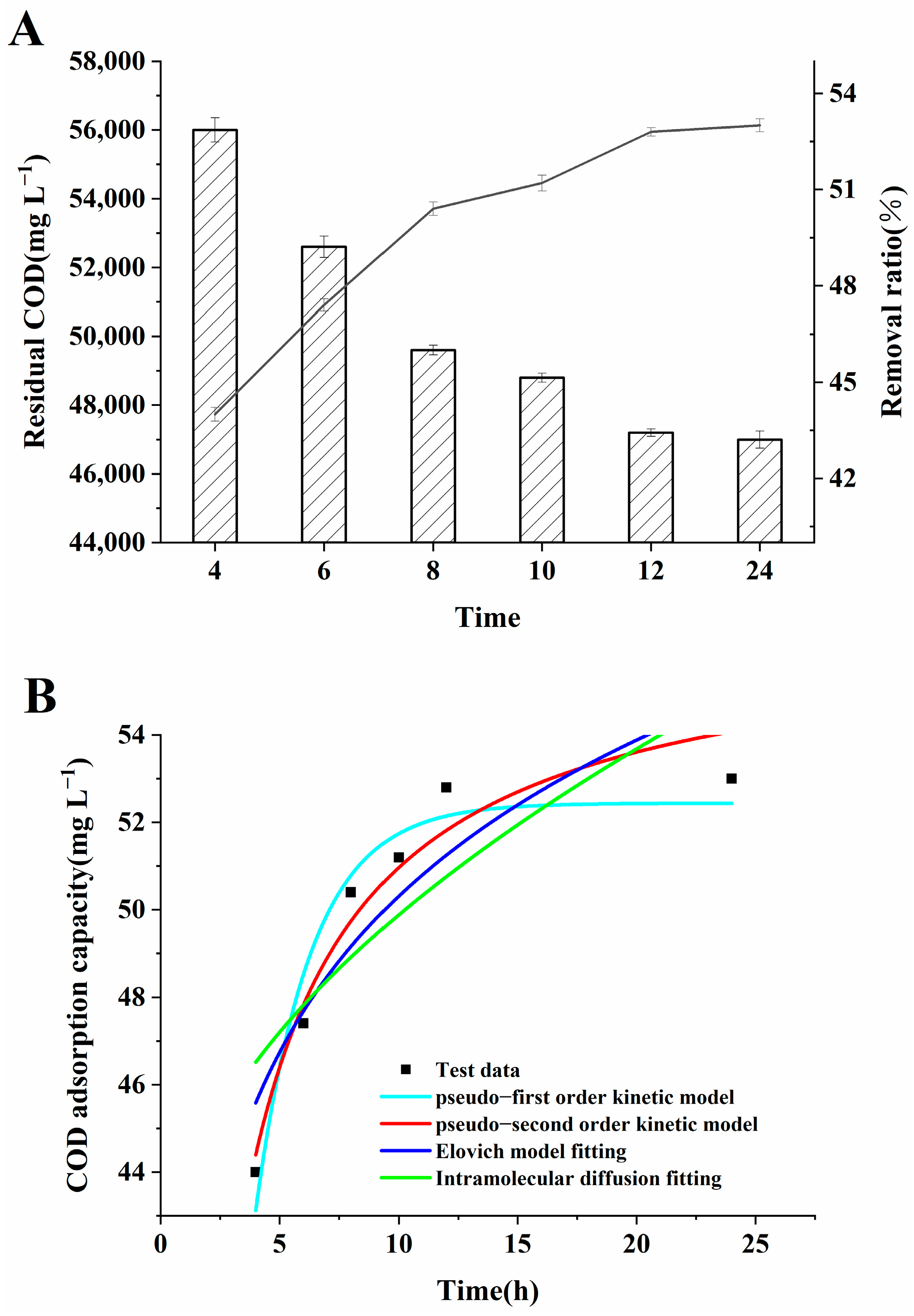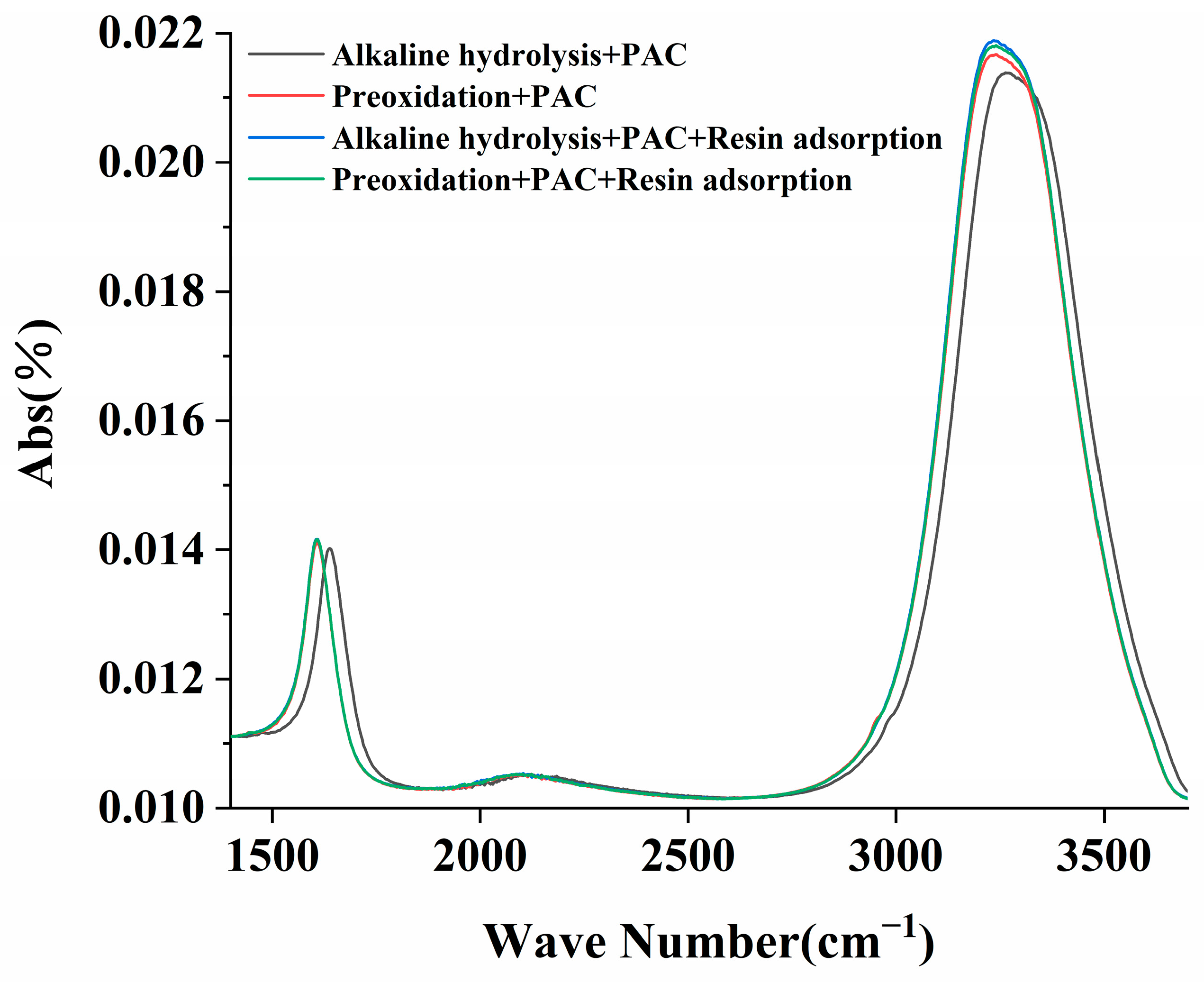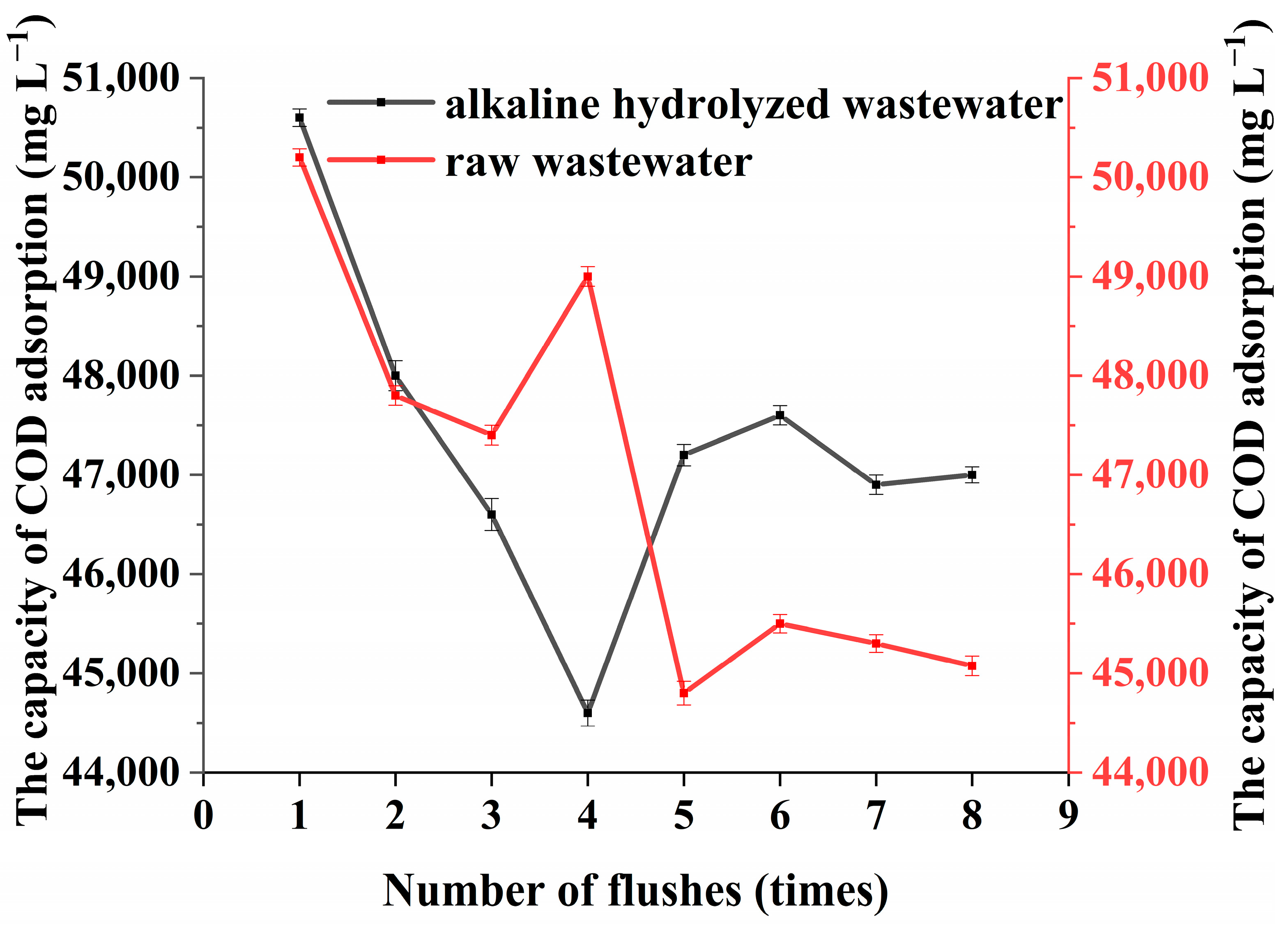Alkaline Prehydrolysis Prolongs Resin Life and Enhances the Adsorption of Phenolic Compounds
Abstract
:1. Introduction
2. Materials and Methods
2.1. Materials
2.2. Methods
2.2.1. Alkaline Prehydrolysis Experiment
2.2.2. Macroporous Resin Adsorption Experiment
2.2.3. Regeneration Life Test of the Macroporous Resin Adsorption–Desorption
2.2.4. Liquid Chromatography–Mass Spectrometry (LC–MS) Detection
3. Results
3.1. Effect of the Hydrolysis pH on the Flocculation and Phenol Removal
3.2. Effect of the Alkaline Hydrolysis Time on the COD Removal
3.3. The Putative Metabolism Pathway of the BHT
3.4. FTIR Characteristic Analysis of the Functional Groups on the Surface of the Flocs after Hydrolysis
3.5. Effect of the Prehydrolysis on Improving the Service Life of the Resin Adsorption
4. Conclusions
Author Contributions
Funding
Data Availability Statement
Conflicts of Interest
References
- Junyi, L.; Yu, Z.; Lei, Z. Research progress in the treatment technologies of industrial wastewater containing phenol. Ind. Water Treat. 2018, 38, 12–16. [Google Scholar]
- González-Muñoz, M.; Luque, S.; Álvarez, J.; Coca, J. Recovery of phenol from aqueous solutions using hollow fibre contactors. J. Membr. Sci. 2003, 213, 181–193. [Google Scholar] [CrossRef]
- Ronggui, F.; Haijuan, G.; Xian, L. New techniques and research progress on phenol-containing wastewater treatment. Technol. Water Treat. 2013, 39, 5–8. [Google Scholar]
- Busca, G.; Berardinelli, S.; Resini, C.; Arrighi, L. Technologies for the removal of phenol from fluid streams: A short review of recent developments. J. Hazard. Mater. 2008, 160, 265–288. [Google Scholar] [CrossRef]
- Zhang, M.; Zhang, Z.; Liu, S.; Peng, Y.; Chen, J.; Ki, S.Y. Ultrasound-assisted electrochemical treatment for phenolic wastewater. Ultrason. Sonochemistry 2020, 65, 105058. [Google Scholar] [CrossRef]
- Zhang, C.; Wang, X.; Ma, Z.; Luan, Z.; Wang, Y.; Wang, Z.; Wang, L. Removal of phenolic substances from wastewater by algae. A review. Environ. Chem. Lett. 2019, 18, 377–392. [Google Scholar] [CrossRef]
- Wang, W.; Kannan, K. Inventory, loading and discharge of synthetic phenolic antioxidants and their metabolites in wastewater treatment plants. Water Res. 2018, 129, 413–418. [Google Scholar] [CrossRef]
- Brillas, E.; Garcia-Segura, S. Benchmarking recent advances and innovative technology approaches of Fenton, photo-Fenton, electro-Fenton, and related processes: A review on the relevance of phenol as model molecule—ScienceDirect. Sep. Purif. Technol. 2020, 237, 116337. [Google Scholar] [CrossRef]
- Xu, Z.; Xiong, X.; Zeng, Q.; He, S.; Yuan, Y.; Wang, Y.; Wang, Y.; Yang, X.; Su, D. Alterations in structural and functional properties of insoluble dietary fibers-bound phenolic complexes derived from lychee pulp by alkaline hydrolysis treatment. LWT 2020, 127, 109335. [Google Scholar] [CrossRef]
- Guzmán, J.; Mosteo, R.; Sarasa, J.; Alba, J.A.; Ovelleiro, J.L. Evaluation of solar photo-Fenton and ozone based processes as citrus wastewater pre-treatments. Sep. Purif. Technol. 2016, 164, 155–162. [Google Scholar] [CrossRef]
- Cao, S.; Jiang, W.; Zhao, M.; Liu, A.; Wang, M.; Wu, Q.; Sun, Y. Pretreatment Hydrolysis Acidification/Two-Stage AO Combination Process to Treat High-Concentration Resin Production Wastewater. Water 2022, 14, 2949. [Google Scholar] [CrossRef]
- Valsania, M.C.; Fasano, F.; Richardson, S.D.; Vincenti, M. Investigation of the degradation of cresols in the treatments with ozone. Water Res. 2012, 46, 2795–2804. [Google Scholar] [CrossRef] [PubMed] [Green Version]
- Hu, C.-Z.; Liu, H.-J.; Qu, J.-H. Coagulation behavior of Al13 species. Huan Jing Ke Xue 2007, 27, 2467–2471. [Google Scholar]
- Wei, N.; Zhang, Z.; Liu, D.; Wu, Y.; Wang, J.; Wang, Q. Coagulation behavior of polyaluminum chloride: Effects of pH and coagulant dosage. Chin. J. Chem. Eng. 2015, 23, 1041–1046. [Google Scholar] [CrossRef]
- Zhaochun, T.; Quanjin, W.; Weiquan, Y. Chlorine oxidation test for phenol-containing wastewater. China Water Wastewater 2002, 18, 42–43. [Google Scholar]
- Yabin, Q.; Pengfei, X.; Jiacheng, R. study on advanced treatment of coal chemical industry phenolic wastewater by Fenton oxidation. Energy Chem. Ind. 2019, 40, 59–62. [Google Scholar]
- Ranran, S. Research on Pretreatment of Phenolic Wasterwater with the Integrated Hydrolysis Acidification-Iron-Carbon Microelectrolysis Reactor; Harbin Institute of Technology: Harbin, China, 2010. [Google Scholar]
- Qiu, H.; Lv, L.; Pan, B.-C.; Zhang, Q.-J.; Zhang, W.-M.; Zhang, Q.-X. Critical review in adsorption kinetic models. J. Zhejiang Univ. A 2009, 10, 716–724. [Google Scholar] [CrossRef]
- Deng, S.; Zhang, Q.; Nie, Y.; Wei, H.; Wang, B.; Huang, J.; Yu, G.; Xing, B. Sorption mechanisms of perfluorinated compounds on carbon nanotubes. Environ. Pollut. 2012, 168, 138–144. [Google Scholar] [CrossRef]
- Wang, F.; Xu, J.; Liao, S.-J. One-step heterogeneously catalytic oxidation of o-cresol by oxygen to salicylaldehyde. Chem. Commun. 2002, 6, 626–627. [Google Scholar] [CrossRef]
- Mei, X.; Guo, Z.; Liu, J.; Bi, S.; Li, P.; Wang, Y.; Shen, W.; Yang, Y.; Wang, Y.; Xiao, Y.; et al. Treatment of formaldehyde wastewater by a membrane-aerated biofilm reactor (MABR): The degradation of formaldehyde in the presence of the cosubstrate methanol. Chem. Eng. J. 2019, 372, 673–683. [Google Scholar] [CrossRef]
- Degirmenci, V.; Uner, D.; Yilmaz, A. Methane to higher hydrocarbons via halogenation. Catal. Today 2005, 106, 252–255. [Google Scholar] [CrossRef]
- Wei, X.; Liu, M.; Lu, K.; Wu, H.; Wu, J. Friedel-Crafts alkylation modification and hydrophilic soft finishing of meta aramid. J. Eng. Fibers Fabr. 2021, 16, 1558925021999061. [Google Scholar] [CrossRef]
- Li, Y.-M.; Sun, S.-Q.; Zhou, Q.; Qin, Z.; Tao, J.-X.; Wang, J.; Fang, X. Identification of American ginseng from different regions using FT-IR and two-dimensional correlation IR spectroscopy. Vib. Spectrosc. 2004, 36, 227–232. [Google Scholar] [CrossRef]
- Liu, H.-X.; Sun, S.-Q.; Lv, G.-H.; Chan, K.K. Study on Angelica and its different extracts by Fourier transform infrared spectroscopy and two-dimensional correlation IR spectroscopy. Spectrochim. Acta Part A Mol. Biomol. Spectrosc. 2006, 64, 321–326. [Google Scholar] [CrossRef] [Green Version]
- Chen, L.; Wei, X.; Wang, H.; Yao, M.; Zhang, L.; Gellerstedt, G.; Lindström, M.E.; Ek, M.; Wang, S.; Min, D. A modified ionization difference UV–vis method for fast quantitation of guaiacyl-type phenolic hydroxyl groups in lignin. Int. J. Biol. Macromol. 2022, 201, 330–337. [Google Scholar] [CrossRef] [PubMed]
- Vijayalakshmi, R.; Ravindhran, R. Comparative fingerprint and extraction yield of Diospyrus ferrea (willd.) Bakh. root with phenol compounds (gallic acid), as determined by uv–vis and ft–ir spectroscopy. Asian Pac. J. Trop. Biomed. 2012, 2, S1367–S1371. [Google Scholar] [CrossRef]
- Tiainen, E.; Drakenberg, T.; Tamminen, T.; Kataja, K.; Hase, A. Determination of Phenolic Hydroxyl Groups in Lignin by Combined Use of 1H NMR and UV Spectroscopy. Holzforschung 1999, 53, 529–533. [Google Scholar] [CrossRef]
- Wang, H.; Cao, X.; Xiao, F.; Liu, S.; Deng, G.-J. Iron-Catalyzed One-Pot 2,3-Diarylquinazolinone Formation from 2-Nitrobenzamides and Alcohols. Org. Lett. 2013, 15, 4900–4903. [Google Scholar] [CrossRef]
- Hong, C.; Zhang, W.; Pan, B.; Lv, L.; Han, Y.; Zhang, Q. Adsorption and desorption hysteresis of 4-nitrophenol on a hyper-cross-linked polymer resin NDA-701. J. Hazard. Mater. 2009, 168, 1217–1222. [Google Scholar] [CrossRef]
- Liu, X. The Preliminary Study on the Effects of the Using-Period of the Extracted Liquids of Chinese Herbal Medice on Absorption and the Regeneration of Fouled Macroporous Absorbing Resin; Nanjing University of Chinese Medicine: Nanjing, China, 2008. [Google Scholar]





| Models | Parameters | |
|---|---|---|
| Pseudo-first-order kinetic model | K1 | 0.432 |
| R2 | 0.93453 | |
| Pseudo-second-order dynamics model | K2 | 0.01616 |
| R2 | 0.93947 | |
| Elovich kinetic model | α | 8891.15855 |
| β | 0.1939 | |
| R2 | 0.78161 | |
| Intra-particle diffusion model | K3 | 2.90067 |
| R2 | 0.6252 |
| Different Treatments | Composition |
|---|---|
| Raw wastewater | m-cresol; 3-methylbenzaldehyde |
| Alkaline hydrolysis | m-tolylmethanol |
| Alkaline hydrolysis + PAC | 3-hydroxy-5-methylbenzyl chloride; 1-methyl-3-[(3-methylphenyl) methylperoxymethyl]benzene |
| Alkaline hydrolysis + PAC + resin adsorption | 6-{[3,5-bis(tert-butyl)-4-hydroxyphenyl]methyl}-2-(tert-butyl)-4-chlorophenol |
| Material | Long | Wide | High | Volume | Diameter |
|---|---|---|---|---|---|
| m-Cresol | 8.653 | 7.189 | 4.018 | 249.95 | 6.3 |
| 4,6-di-tert-butyl-m-cresol | 10.752 | 8.196 | 6.505 | 573.24 | 8.306 |
| 2,6-di-tert-butyl-4-methylphenol (BHT) | 11.453 | 8.990 | 6.505 | 669.77 | 8.75 |
| 3-Methylbenzaldehyde | 9.022 | 7.316 | 4.018 | 265.21 | 6.424 |
| m-tolylmethanol | 8.868 | 7.736 | 4.019 | 275.71 | 6.508 |
| 3-hydroxy-5-methylbenzyl chloride | 11.116 | 8.087 | 4.019 | 361.29 | 8.322 |
| 1-methyl-3-[(3-methylphenyl) methylperoxymethyl]benzene | 15.773 | 8.040 | 4.545 | 576.37 | 8.255 |
| 6-{[3,5-bis(tert-butyl)-4-hydroxyphenyl]methyl}-2-(tert-butyl)-4-chlorophenol | 15.372 | 10.212 | 8.312 | 1304.8 | 10.928 |
Disclaimer/Publisher’s Note: The statements, opinions and data contained in all publications are solely those of the individual author(s) and contributor(s) and not of MDPI and/or the editor(s). MDPI and/or the editor(s) disclaim responsibility for any injury to people or property resulting from any ideas, methods, instructions or products referred to in the content. |
© 2023 by the authors. Licensee MDPI, Basel, Switzerland. This article is an open access article distributed under the terms and conditions of the Creative Commons Attribution (CC BY) license (https://creativecommons.org/licenses/by/4.0/).
Share and Cite
Gu, C.; Yan, K.; Bo, L.; Zhou, X.; He, Y.; Feng, J.; Qin, J. Alkaline Prehydrolysis Prolongs Resin Life and Enhances the Adsorption of Phenolic Compounds. Water 2023, 15, 2566. https://doi.org/10.3390/w15142566
Gu C, Yan K, Bo L, Zhou X, He Y, Feng J, Qin J. Alkaline Prehydrolysis Prolongs Resin Life and Enhances the Adsorption of Phenolic Compounds. Water. 2023; 15(14):2566. https://doi.org/10.3390/w15142566
Chicago/Turabian StyleGu, Chao, Kailing Yan, Lei Bo, Xin Zhou, Yiwen He, Jiacheng Feng, and Jinyi Qin. 2023. "Alkaline Prehydrolysis Prolongs Resin Life and Enhances the Adsorption of Phenolic Compounds" Water 15, no. 14: 2566. https://doi.org/10.3390/w15142566




